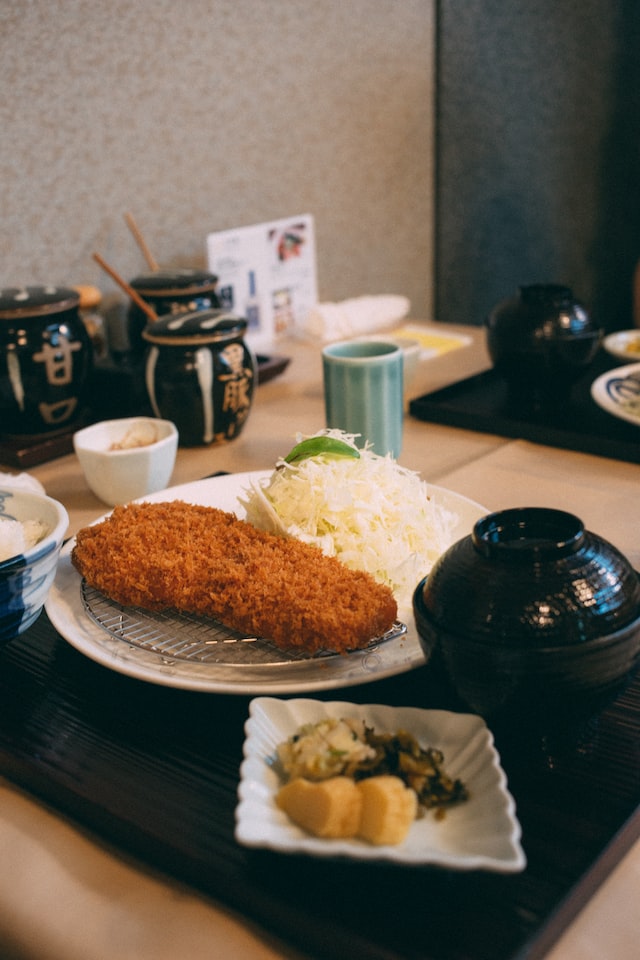
As I stepped into the cozy Yoshoku restaurant, a burst of savory aroma welcomed me. The elegant interior design and soft background music set the tone for a delightful dining experience.
The menu was filled with an array of Japanese western-style dish options – from succulent fried chicken and huge servings of tonkatsu to the delectable beef curry rice, my taste buds were already tingling with excitement. Where traditional Japanese cuisine or washoku focuses on seasonal ingredients, Yoshoku cuisine, on the other hand, incorporates both Western and Japanese influences into its dishes.
I ordered the signature dish, Omu-rice, and eagerly anticipated its arrival. Soon, I was presented with a plate of perfectly seasoned fried rice, draped with a fluffy omelet and delicately drizzled with tangy tomato sauce.
As I took my first bite of Omu-rice, I savored the distinct flavors and textures of the dish. The softness of the omelet complemented the crispiness of the rice, while the sweetness of the tomato sauce balanced the saltiness of the fried rice.
As I finished the last bite of my meal, I couldn’t resist ordering the exquisite dessert – a divine fusion of Japanese and western cuisine – the green tea tiramisu. It was an enchanting sight with its vibrant green layers of matcha sponge and velvety mascarpone cream topped with a sprinkle of matcha powder.
The exquisite taste left me at a loss for words, and I could not articulate my joy. This delightful dining experience was truly a symphony of flavors, and Yoshoku restaurant was an extraordinary example of excellence in fusion cuisine.
What is Yoshoku?
Yoshoku (洋食) is a type of Japanese cuisine that was developed during the Meiji period (1868-1912) when Japan opened up to the rest of the world and began adopting Western cuisine. Yoshoku literally means “Western food” in Japanese, and refers to a style of cooking that incorporates Western ingredients and cooking techniques into Japanese cuisine.
Some common examples of Yoshoku dishes include:
- Tonkatsu (とんかつ) – This is a breaded and deep-fried pork cutlet, often served with a sweet and savory sauce and shredded cabbage.
- Omurice (オムライス) – This is a dish of fried rice wrapped in a thin omelette, often served with ketchup or a demi-glace sauce.
- Hayashi rice (ハヤシライス) – This is a dish of beef stew served over rice, often flavored with red wine and a tomato-based sauce.
- Korokke (コロッケ) – This is a deep-fried patty of mashed potatoes and meat or seafood, similar to a Western-style croquette.
Spaghetti Napolitan (スパゲティーナポリタン) – This is a Japanese-style spaghetti dish made with ketchup, vegetables, and often ham or sausage.
Yoshoku dishes can vary in their level of fusion between Japanese and Western cuisine, but they generally feature a balance between Japanese and Western ingredients and flavors. Yoshoku cuisine has become a beloved part of Japanese cuisine, with many restaurants and home cooks specializing in its unique dishes.
What isn’t yoshoku?
Yoshoku refers to western food done in a Japanese style. Therefore, hamburgersm french fries, hot dogs, and other western foods are not traditionally considered Yoshoku cuisine, as they are primarily associated with American cuisine. However, they have become popular and widely available in Japan, and are often served in Japanese-style cafes and restaurants alongside Yoshoku dishes.
In some cases, Japanese-style variations of hamburgers and fries have been developed that incorporate elements of Yoshoku cuisine. For example, some restaurants in Japan serve hamburgers topped with teriyaki sauce, wasabi mayonnaise, or other Japanese-style condiments, and some cafes offer fries sprinkled with seaweed or other Japanese seasonings. These could be considered yoshoku.

